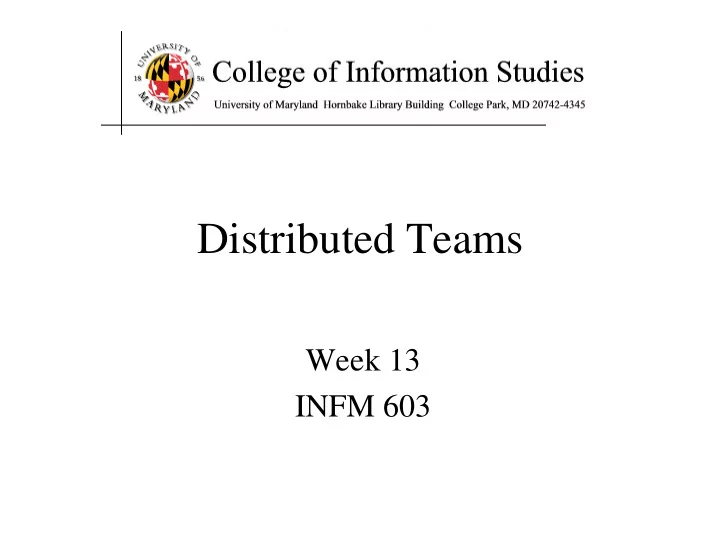

Distributed Teams Week 13 INFM 603
Agenda • Distributed teams • Project presentation prep • Final exam prep
Strategic Choices • Acquisition – Proprietary (“COTS”) – Open source • Implementation – Integrate “Best-of-breed” systems – “One-off” custom solution
Global Software Development Barriers Solutions • Geographic distance • Cultural ambassadors • Temporal distance • Configuration management • Linguistic & cultural distance • Face to face kickoffs • Fear and trust • Modularity • Organizational structure • Well defined interfaces • Process • Effective handoffs • Infrastructure • Win-win strategies • Project Architecture
Extreme Programming • Planning game • Collective ownership • Customer involvement • Sustainable pacing • Coding standards • Metaphor • Simplicity of design • Pair programming • Continuous integration • Refactoring • Small functional releases
Open Source “Pros” • More eyes ⇒ fewer bugs • Iterative releases ⇒ rapid bug fixes • Rich community ⇒ more ideas – Coders, testers, debuggers, users • Distributed by developers ⇒ truth in advertising • Open data formats ⇒ Easier integration • Standardized licenses
Open Source “Cons” • Communities require incentives – Much open source development is underwritten • Developers are calling the shots – Can result in feature explosion • Proliferation of “orphans” • Diffused accountability – Who would you sue? • Fragmentation – “Forking” may lead to competing versions • Little control over schedule
Total Cost of Ownership • Planning • Installation – Facilities, hardware, software, integration, migration, disruption • Training – System staff, operations staff, end users • Operations – System staff, support contracts, outages, recovery, …
Total Cost of Ownership
Open Source Business Models • Support Sellers Sell distribution, branding, and after-sale services. • Loss Leader Give away the software to make a market for proprietary software. • Widget Frosting If you’re in the hardware business, giving away software doesn’t hurt. • Accessorizing Sell accessories: books, compatible hardware, complete systems with pre-installed software
Project Presentations • Maximum of 25 minutes • Goals (from the user’s perspective) • Demo • Task division between partners • Most interesting implementation details • Complete list of limitations • Lessons learned • Project process improvement (optional)
Final Exam • 2 hours – Starts at 6:00 sharp (be early) – Ends at 8:00 sharp • Take it anywhere – Classroom will be available – Ask me questions by email or phone • Open everything – But no communication with any other person • Available from the Web and by email • Submitted to me by email
Unified Modeling Language • Real systems are more complex than anyone can comprehend • Key idea: Progressive refinement – Carve the problem into pieces – Carve each piece into smaller pieces – When the pieces are small enough, code them • UML provides a formalism for doing this – But it does not provide the process
Unified Modeling Language
Specifying Structure • Capturing the big picture – Use case diagram (interactions with the world) – Narrative – Scenarios (examples to provoke thinking) • Designing the object structure – Class diagram (“entity-relationship” diagram) – Object diagram (used to show examples)
Specifying Behavior • Represent a candidate workflow – Activity diagram (a “flowchart”) • Represent object interactions for a scenario – Collaboration diagram (object-based depiction) – Sequence diagram (time-based depiction) • Represent event-object interactions – Statechart diagram (a “finite state machine”)
Use Case Design • Use Case Diagram – Input-output behavior • Use Case Narrative – Explains each use case • Use Case Scenario – Activity diagram shows how the use cases are used together
Use Case Diagram
Use Case Diagram • External “actors” – Roles of people – Types of systems • Use cases – Top-level functions (solid arrows to/from actors) • Relationships among use cases – Always-depends-on (dashed <<include>>) – Sometimes-is-depended-on (dashed <<extend>>) – Inherits-from (solid triangle-arrow)
Activity Diagram : Modeling Decisions [ l o w P r i o r i t y ] O p e n A l l o c a t e I n c i d e n t R e s o u r c e [ f i r e & h i g h P r i o r i t y ] [ n o t f i r e & h i g h P r i o r i t y ] N o t i f y F i r e C h i e f N o t i f y P o l i c e C h i e f Thanks to Satish Mishra
Sequence Diagram ECDSH's Detailed info Seacrh Database main web page page engine :User Time input search criteria search songs/disks by criteria sumbit Activation verify return display pick up a disk Message see detailed info load page search det. info sumbit verify return display Thanks to Satish Mishra
Good Uses for UML • Focusing your attention – Design from the outside in • Representing partial understanding – Says what you know, silent otherwise • Validate that understanding – Structuring communication with stakeholders
Avoiding UML Pitfalls • Don’t sweat the notation too much – The key is to be clear about what you mean! • Don’t try to make massive conceptual leaps – Leverage encapsulation to support abstraction • Don’t get to attached to your first design – Goal is to find weaknesses in your understanding
Recommend
More recommend